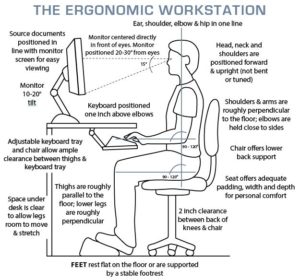Doctors of chiropractic, like our own Dr. Neil, are trained in proper body mechanics and assessing for improper body positioning and motion. By using this body mechanic knowledge of bringing the body to neutral positions for work, Dr. Neil educates on how to avoid WMSD, or Work-Related Musculoskeletal Disorders, like carpal tunnel syndrome, tendinitis, rotator cuff injuries, epicondylitis (affects the elbow), muscle strains and low back injuries. These work-related MSDs are the highest reported cause of lost time at work and accounted for 33% of all worker injury and illness cases in 2013, according to the Bureau of Labor Statistics. However, work-related MSDs can be prevented. Ergonomics, or fitting a job to a person, helps lessen muscle fatigue, increases productivity and reduces the number and severity of work-related MSDs.
Prevent Injury from Repetitive Tasks with Proper Ergonomics
Ergonomics takes into consideration many different aspects of the work environment. For this post we are focusing on an occupation with a sedentary position, typically at a desk or workstation for the majority of their workday. For these types of occupations the most common injuries are bursitis, carpal tunnel syndrome, muscle strains (neck, upper back, lower back and shoulders) and tendon injury. An ergonomic workstation can be the key to reducing your risk of musculoskeletal injuries at work. Establishing and maintaining an ergonomically appropriate workstation includes considering a wide range of factors:
- Accessibility of items: How far an employee has to reach for necessary items in an important consideration for promoting an ergonomically healthy workspace.
- Time spent standing or sitting: A great deal of work is performed in either standing or sitting positions with little or no change in position. Regular breaks for stretching and moving will help minimize the risk of degenerative joint diseases. Avoid staying in a single position for more than 20 minutes. Regular stretching makes the joints functional, flexible and mobile.
- Chair Design and Sitting : For work that requires prolonged inactivity or sitting, it is important to properly position the chair to maximize efficiency and minimize stress on the body.

Proper Chair Design & Posture
- Position the armrests so that the forearms are parallel the ground.
- Adjust the backrest to support mid and lower back. Unfortunately, many chairs cannot support lumbar ridges, which may result in lower back pain, disc problems, pelvic dysfunction, and premature osteoarthritis.
- Position the knees so they are at or below hip level.
- Keep the mouse and pad about 1-2 inches above the keyboard level.
- Avoid leg crossing. Rest feet flat on the floor and avoid putting excessive pressure on heels or toes. The small joints of our feet suffer pain and pressure due to wrong choice of shoes, improper positioning, and inadequate arch support.
- Avoid twisting and turning the head to view documents when working at a computer. Keep documents in a document holder or a viewing stand close to the monitor.
- Keep the computer equipment on a stable surface that does not wobble or tilt.
- Use an external monitor or laptop stand when using a laptop. These computers are often positioned too low, requiring users to tilt their heads downward for proper viewing.
While ergonomic products like gel-filled wrist supports, gloves, and braces may provide some comfort, they do not make up for bad posture. Be sure to maintain correct posture while working on a computer or a desk.
Superior Spine Care: Advocate for Ergonomics
If you are an employer concerned about preventing injury at your company, Superior Spine Care can help educate and implement proper ergonomics to reduce strain and the risk of employees becoming injured. If you are an employee concerned that you already show signs of a musculoskeletal injury like bursitis, carpel tunnel syndrome, muscle strains or tendon injury schedule an appointment to see the team at Superior Spine Care. Our chiropractic treatment, physical therapy and rehabilitation, as well as our therapeutic massage, employs a variety of techniques involving manual stimulation, and has been effective in tackling many MSDs.


[…] about that when we send our kids to sit at a desk for 6 hours of the day? We should. “Avoid Musculoskeletal Disorders (MSDs) With Ergonomics” is a previous post that has the perfect illustration for your child to have proper posture […]